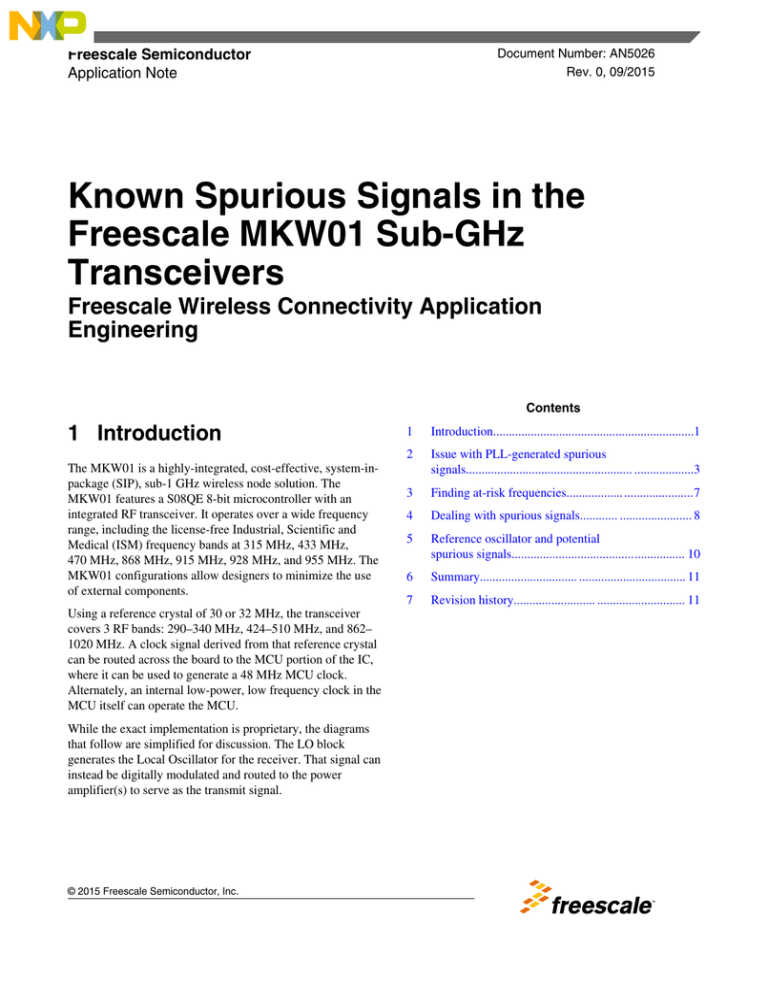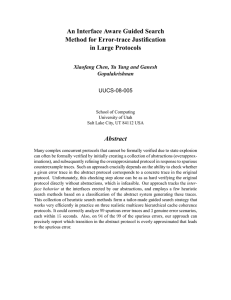
Freescale Semiconductor
Application Note
Document Number: AN5026
Rev. 0, 09/2015
Known Spurious Signals in the
Freescale MKW01 Sub-GHz
Transceivers
Freescale Wireless Connectivity Application
Engineering
Contents
1 Introduction
The MKW01 is a highly-integrated, cost-effective, system-inpackage (SIP), sub-1 GHz wireless node solution. The
MKW01 features a S08QE 8-bit microcontroller with an
integrated RF transceiver. It operates over a wide frequency
range, including the license-free Industrial, Scientific and
Medical (ISM) frequency bands at 315 MHz, 433 MHz,
470 MHz, 868 MHz, 915 MHz, 928 MHz, and 955 MHz. The
MKW01 configurations allow designers to minimize the use
of external components.
Using a reference crystal of 30 or 32 MHz, the transceiver
covers 3 RF bands: 290–340 MHz, 424–510 MHz, and 862–
1020 MHz. A clock signal derived from that reference crystal
can be routed across the board to the MCU portion of the IC,
where it can be used to generate a 48 MHz MCU clock.
Alternately, an internal low-power, low frequency clock in the
MCU itself can operate the MCU.
While the exact implementation is proprietary, the diagrams
that follow are simplified for discussion. The LO block
generates the Local Oscillator for the receiver. That signal can
instead be digitally modulated and routed to the power
amplifier(s) to serve as the transmit signal.
© 2015 Freescale Semiconductor, Inc.
1
Introduction................................................................1
2
Issue with PLL-generated spurious
signals..................................................... ...................3
3
Finding at-risk frequencies.................. ......................7
4
Dealing with spurious signals............ ....................... 8
5
Reference oscillator and potential
spurious signals....................................................... 10
6
Summary............................... .................................. 11
7
Revision history.......................... ............................ 11
Introduction
Figure 1. Transceiver block diagram
The PLL runs at approximately 1800 MHz. This internal signal can be divided by 1, 2, or 3 resulting in: 1800, 900, or
600 MHz. This is fed to the quadrature generator, which includes a further divide-by-2, producing IQ signals needed for the
receiver. Only one is needed for the transmitter. The total divide ratio of 2, 4, or 6, results in the required Receiver LO or TX
signal in the range of 900, 450, or 300 MHz.
Known Spurious Signals in the Freescale MKW01 Sub-GHz Transceivers, Rev. 0, 09/2015
2
Freescale Semiconductor, Inc.
Issue with PLL-generated spurious signals
Figure 2. LO Block Simplified Block Diagram
2 Issue with PLL-generated spurious signals
Generally, a spurious signal is any emission that is not directly related to the carrier frequency. Hardware emissions
specifications for various world-wide radio standards limit the level of spurious signals permitted, the user must avoid
generating spurious signals.
2.1 Spurious emissions
The internally generated clock or reference signals and their harmonics can couple on the silicon die of the transceiver into
the LO Synthesizer, and create spurious signals on the transmitted signal. Therefore, synthesizer spurs and reference
oscillator spurs are all considered spurious emissions.
2.2 Harmonics
Harmonics are often treated to a different limit than other spurious signals, due to the way they are generated and suppressed
(output filter). Therefore, they are not addressed in this application note.
• The harmonics of the reference oscillator can couple to the PLL circuitry, and any integer harmonic landing near an
active frequency is passed to the LO and transmitter, or they mix.
2.2.1 Three major spur families
2.2.1.1
Reference harmonics in-band
Known Spurious Signals in the Freescale MKW01 Sub-GHz Transceivers, Rev. 0, 09/2015
Freescale Semiconductor, Inc.
3
Issue with PLL-generated spurious signals
Integer harmonics of the reference crystal landing in the operate band (FLO) are considered the strongest spur family. For
convenience, we call these first order spurious. The signal is injected into the FLO path and creates a fixed spurious signal at
the harmonic of the reference. With a 32 MHz crystal, these spurious signals land at channels near the following frequencies:
For the 900 MHz band: 864 MHz, 928 MHz, and 960 MHz, and for the 450 MHz band: 448 MHz, 480 MHz, and 320 MHz
in the 300 MHz band. This appears as a spurious sideband to a given offset from the carrier. As the signal wraps through the
PLL and the dividers, other signals such as the image of the same offset to the other side, and multiples there-of, are created.
These figures provide examples of first order spurs around 480 MHz.
Figure 3. Diagram illustrating first order spurious mechanism, 480 MHz
As seen in the sidebar of the following figure, the spurious signal remains at 480 MHz even as the carrier is moved away.
Figure 4. Showing first order (and higher order) spurs, 480 MHz
Known Spurious Signals in the Freescale MKW01 Sub-GHz Transceivers, Rev. 0, 09/2015
4
Freescale Semiconductor, Inc.
Issue with PLL-generated spurious signals
2.2.1.2
Reference harmonics near internal signal
Integer harmonics landing near the frequency of the internally divided signal, Fvco/M (in the 900 MHz region when M=2 is
operating in the 450 MHz band). When they are weaker, they mix before the quadrature generator and divider, and create a
2*Foffset spur (second order spurious). These figures provide examples of second order spurs around 496 MHz.
Figure 5. Diagram illustrating second order spurious mechanism, 496 MHz
Figure 6. Showing second order (and higher order) spurs, 496 MHz
Known Spurious Signals in the Freescale MKW01 Sub-GHz Transceivers, Rev. 0, 09/2015
Freescale Semiconductor, Inc.
5
Issue with PLL-generated spurious signals
2.2.1.3
Reference harmonics near VCO
Integer harmonics landing near the frequency of the VCO itself, in the 1900 MHz band (Fvco), are weakest. These mix in the
VCO path and create a 4*Foffset spur. (third order spurious signals). These figures provide examples of third order spurs
around 472 MHz.
Figure 7. Diagram illustrating third order spurious mechanism, 472 MHz
Known Spurious Signals in the Freescale MKW01 Sub-GHz Transceivers, Rev. 0, 09/2015
6
Freescale Semiconductor, Inc.
Finding at-risk frequencies
Figure 8. Showing third order spurs, 472 MHz
3 Finding at-risk frequencies
Spurious signals have been observed on only a few channels in a given band. To avoid searching every channel on a
spectrum analyzer, a simple calculation can predict which frequencies cause spurious, and the nearby channels can be tested.
By creating a spreadsheet, the user can build a spurious map showing where spurious signals occur. On each row in the first
column, list the frequency of integer megahertz steps of FRF of the band in question. With FREF topping certain columns, each
cell in that column has a formula to divide that row’s FRF by the FREF. Include similar columns for FVCO and FVCO/M.
Search for or create a flag that looks for integer numbers in the divide ratios (FLO/FREF, (FVCO/M)/FREF and FVCO/FREF)
calculated in the cells.
The spurious-map segment in the following figure shows that 480 MHz has spurious based on FLO. These are called firstorder spurious, and are known to be the strongest or worst spurs. There are also spurious signals near 496 MHz and
472 MHz, which are second and third order spurious signals that have been previously described.
Known Spurious Signals in the Freescale MKW01 Sub-GHz Transceivers, Rev. 0, 09/2015
Freescale Semiconductor, Inc.
7
Dealing with spurious signals
Figure 9. Search for channels near integer harmonics of a 32 MHz FREF to identify areas
with a risk of spurious signals
Use M=3 when creating a spur search for the 300 MHz band, or M=1 for a 900 MHz band search.
After identifying the frequencies where an integer harmonic of the reference signal occurs, check the spectrum for several
megahertz around several adjacent channels above and below that frequency. Depending on the level of the generated
spurious signals, some number of close-in channels may cause spurious signals that exceed the permitted level.
4 Dealing with spurious signals
4.1 Selecting FREF
The MKW01 Transceiver allows the reference oscillator to be chosen in the 26 to 32 MHz range, with the 32 MHz being the
default.
Selecting a reference frequency that does not have a harmonic that falls in-band at the output, intermediate, or VCO
frequencies can avoid spurious. Again, avoiding “first order” spurious is more important than “second order” or “third order”
spurious signals, due to the level of spurious created by each mechanism.
There are internal hardware limits on the divide ratio to ensure “illegal” (beyond the VCO tuning range) frequencies cannot
be programmed when using a 32 MHz reference. If the chosen alternate FREF requires such a divide ratio to achieve an
otherwise “legal” frequency, it may not be possible to tune to that frequency.
All of the internal receive bandwidth signals, bit rate settings, deviation settings, frequency steps, and so on, are derived from
FREF. Selecting an alternate FREF requires software being changed to correctly calculate all of these numbers.
The formula to calculate bit rate may result in a bit rate exactly as desired, or the nearest step. For instance, 32 MHz and
30 MHz can both divide down to create a 100 kbit/s bit rate exactly. However, the 30 MHz FREF creates a 4800 bit/s bit rate
exactly, whereas the 32 MHz FREF creates 4800.48 bit/s, or nearly a half Hz error. This may seem small, but that 100 ppm
error exceeds some specs. Two boards with the same bit rate offset can communicate with each other, but a board with a
given bit rate offset communicating with a board (of legacy design for instance, or a competitor’s or partner’s product)
without that same offset in bit rate may result bit or packet errors.
All of these issues should be considered before finalizing a decision on using an alternate FREF.
Known Spurious Signals in the Freescale MKW01 Sub-GHz Transceivers, Rev. 0, 09/2015
8
Freescale Semiconductor, Inc.
Dealing with spurious signals
The two standard reference frequencies commonly used with the MRB-KW01 are 30 MHz and 32 MHz. While 32 MHz is
recommended for most applications, 30 MHz was chosen for Japan 920 MHz band products to avoid spurious signals in
band, and is supplied in MRB-KW01-9030JA evaluation boards. Both 30 MHz and 32 MHz references create a spurious-rich
region near 480 MHz.
4.2 PLLBW
While only one red arrow is shown in the previous diagrams symbolizing on-chip leakage contributing to the generation of
spurious signals, there are actually multiple such paths some inside the PLL loop bandwidth and some outside.
For spurious signals created by mixing components present inside the PLL loop, decreasing the loop bandwidth reduces those
spurs Use RegTestPLL 0x5F for this. Decreasing the loop bandwidth also reduces phase noise sidebands.
With changes to the default PLL Bandwidth, tests should be performed measure improvement in spurs while also checking
that there is no adverse affect on modulation caused by the narrower loop bandwidth. Where-as leakage paths bypassing the
PLL filter, adjusting loop bandwidth has less of an effect.
The figure provides a comparison of the effect of PLL bandwidth, showing 600 KHz on the left, and 75 KHz on the right on
spurious on the 480.1 MHz signal. Note one pair of spurious is only marginally affected by PLLBW.
Figure 10. Comparison of effect of PLL bandwidth
4.3 Channel lockout
After mapping out regions of likely spurious signals and choosing an FREF to eliminate spurious signals where feasible, and
adjusting PLLBW to reduce those that remain, it may be necessary to lockout certain channels.
Using the previous examples, the 480 MHz region is known to generate spurious. There were 100 KHz and higher spurs on
479.9, 481.1, and other nearby channels.
NOTE
The channel lockout solution, especially with frequency hopping, may limit system
performance, standards compliance or interoperability with legacy or alternate vendor
equipment.
Known Spurious Signals in the Freescale MKW01 Sub-GHz Transceivers, Rev. 0, 09/2015
Freescale Semiconductor, Inc.
9
Reference oscillator and potential spurious signals
The figure below shows a spectrum plot taken from a signal in a region (470 MHz) where PLL spurious signals are not
generated, in comparison to previous figures.
Figure 11. Spectrum plot of a signal in region (470 MHz)
5 Reference oscillator and potential spurious signals
Another completely unrelated mechanism for generating spurious or undesired signals is leakage of the clock frequency offchip.
Figure 12. MKW01Z128 Clock connections
The reference for the RF transceiver is typically generated with an off-chip crystal and the on-die oscillator (XTA, XTB).
• 32 MHz is the recommended frequency for most applications.
• 30 MHz is the most common alternate frequency. This would be choosen to move PLL spurious signal out of a desired
band.
This reference, at the fundamental frequency or divided down to a lower frequency, is typically routed (off-chip but onboard) from the CLKOUT pin of the transceiver, to the EXTAL0 pin of the MCU, to provide the main clock for the MCU
section of the IC.
Known Spurious Signals in the Freescale MKW01 Sub-GHz Transceivers, Rev. 0, 09/2015
10
Freescale Semiconductor, Inc.
Summary
This reference signal, which is rich in harmonics, routed off-chip, and across the board, can leak into other on-board circuitry
and create entirely new spurious signals. It can also be radiated into the air and become an “unintentional radiated emission”,
or couple to other circuit elements with off-board wired connections and create “conducted spurious” signals. A 32 MHz
FREF can radiate or couple an unwanted signal at 32 MHz or 96 MHz, or cause additional problems.
The CLKOUT path from the transceiver to the MCU should be isolated from other circuitry, routed as controlled impedance,
shielded, or run close to ground. Structures that can act as an antenna should be avoided on that path (the MRB-KW01 has a
jumper on that path which acts as an antenna). For example, selecting a divide ratio for CLKOUT (in RegDioMapping2) and
routing that signal at 2 MHz instead of 32 MHz can reduce radiation simply because the offending structure is a smaller
fraction of a wavelength of the lower frequency and less efficient as an “antenna”.
6 Summary
Numerous mechanisms create spurious signals on the carrier or other circuit traces, some of which allow radiated emissions.
• Only specific frequences (those near harmonics of FREF) are affected.
• Radiated FREF spurs can also occur.
Solutions:
•
•
•
•
•
Selecting a different FREF can move spurious regions out of band.
A more narrow PLL loop bandwidth eliminates some spurious.
Locking out channels that fall in spurious regions.
Careful layout can reduce radiated emissions.
Selection of CLKOUT can reduce radiated emissions.
7 Revision history
The following table contains a history of changes made to this user's guide.
Table 1. Revision history
Revision number
Date
Substantive changes
0
09/2015
Initial release
Known Spurious Signals in the Freescale MKW01 Sub-GHz Transceivers, Rev. 0, 09/2015
Freescale Semiconductor, Inc.
11
How to Reach Us:
Home Page:
freescale.com
Web Support:
freescale.com/support
Information in this document is provided solely to enable system and
software implementers to use Freescale products. There are no express
or implied copyright licenses granted hereunder to design or fabricate
any integrated circuits based on the information in this document.
Freescale reserves the right to make changes without further notice to
any products herein. Freescale makes no warranty, representation, or
guarantee regarding the suitability of its products for any particular
purpose, nor does Freescale assume any liability arising out of the
application or use of any product or circuit, and specifically disclaims
any and all liability, including without limitation consequential or
incidental damages. “Typical” parameters that may be provided in
Freescale data sheets and/or specifications can and do vary in different
applications, and actual performance may vary over time. All operating
parameters, including “typicals,” must be validated for each customer
application by customer’s technical experts. Freescale does not convey
any license under its patent rights nor the rights of others. Freescale
sells products pursuant to standard terms and conditions of sale, which
can be found at the following address: www.freescale.com/
salestermsandconditions.
Freescale, the Freescale logo, and Kinetis are trademarks of Freescale
Semiconductor, Inc., Reg. U.S. Pat. & Tm. Off. All other product or
service names are the property of their respective owners. All rights
reserved.
© 2015 Freescale Semiconductor, Inc.
Document Number AN5026
Revision 0, 09/2015



